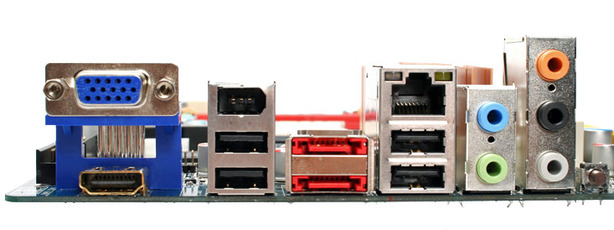Rear I/O
The rear I/O is pretty well featured considering it also has to accommodate the video outputs as well;- HDMI out
- D-sub (VGA) out
- Four USB 2.0 sockets
- One 6-pin Firewire socket
- Two eSATA ports
- Five 3.5mm audio jacks supplying the 7.1 channel High-Definition audio.
The eSATA ports are directly connected to the Nvidia chipset, so any internal RAID array can be expanded to the eSATA ports if necessary. There are only four USB 2.0 ports but there are a couple more in the front, although six is all you're getting unfortunately.

BIOS
| CPU Frequency (1MHz Increment) | 200-300MHz |
| PCI-Express Frequency (1MHz Increment) | 100-150MHz |
| Chipset Voltage (0.1V Increment) | 1.3-1.5V |
| Memory Voltage (0.02V Increment) | 1.82-2.42V |
| CPU Voltage (10mV Increment) | +10-400mV |
| IGP Buffer Size | 64MB/128MB/256MB |
| Memory Clock | 533/667/800MHz |
This BIOS is reasonably well laid out, although the options are somewhat limited – this is to be expected. Given the small passive cooling on the chipset there's only a little extra voltage available, but it's pointless without the option to increase the GPU clock. There's enough memory voltage to keep the vast majority of people happy, although again it's pointless because we were unable to adjust any of the memory timings without the system continually resetting itself before POST.
This was regardless of the performance memory we'd used but the CPU voltage and memory adjustments are actually quite fine at 0.01 and 0.02V respectively.
The option to use extra memory for the IGP is not really needed given its power – its default is 128MB and that should be more than enough for any application it can handle.
Just letting the BIOS handle its own settings left the XPC perfectly stable and it would boot every time – not once during testing or extended sessions watching DVDs or HD video did it throw a fit, only when we tried to tune it for benchmarking. If you do fancy a play though there are a dozen options, of which the usual five (tCAS, tRAS, tRP, tRRD, tRCD) are there although without the command rate option and all are randomly strewn between the other options making it harder to know what's what.
Finally there's the usual fan speed setting – and while the auto-adjustment works exceptionally well at keeping the CPU cool and noise to a minimum, it does get annoying when it constantly whirs up and down. The only one worth using is the ultra low fan speed but obviously unless you're using a very low power CPU (like the 45W Athlon X2 BE-2350) then it'll easily overheat.

MSI MPG Velox 100R Chassis Review
October 14 2021 | 15:04









Want to comment? Please log in.